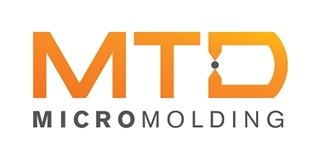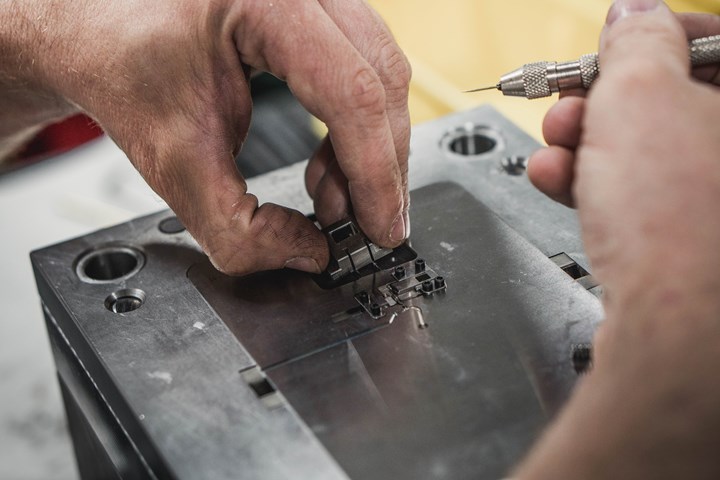
MTD Micro Molding is a contract medical device manufacturer for micro components and finished devices with a team specializing in complex geometries, custom assembly and materials expertise. Photo Credit, all images: MTD Micro Molding
Who is MTD Micro Molding?
Kyle Kolb, Tooling Supervisor: MTD is a medical micro molding company, proudly celebrating its 50th anniversary this year The business began under the name Miniature Tool & Die in the basement of the founder’s home in 1972 and at that time, the business was focused on tooling only, primarily wire EDM. When the founder’s son, Dennis Tully, took the helm in the early 2000s, he began transitioning the business to build micro tools solely to support the growing micro injection molding business and in 2010, Miniature Tool & Die was renamed MTD Micro Molding.
Today, MTD is a contract manufacturer serving many of the top 20 medical OEMs, creating incredibly tiny and powerful components and finished devices. We specialize in manufacturing complex micro geometries and being a strategic partner for our customers by providing materials expertise and services like custom assembly and packaging.
Featured Content
Last year, we grew our footprint from 16,000 square feet to 28,000 square feet at our Charlton, Massachusetts, location (complete with a brand-new state-of-the-art tooling center), which effectively doubled our medical manufacturing space.
Share your job function and brief background.
Kolb: My role at MTD is tooling supervisor and I oversee day-to-day operations of the tooling department. I am also the tooling designer, handling all mold designs and end of arm tooling (EOAT) designs, fixtures and gages. For most of my 30 years in the industry, I focused on injection mold design and product design. I have also worked for standalone mold builders and vertically integrated medical device manufacturers.
What is the key to MTD’s success in micro moldmaking?
Kolb: Our employees are the key providing us with the right tools to be successful. We have some of the most talented toolmakers I have ever met. They range in experience level from just a few years to a few decades and each brings something unique to the table.
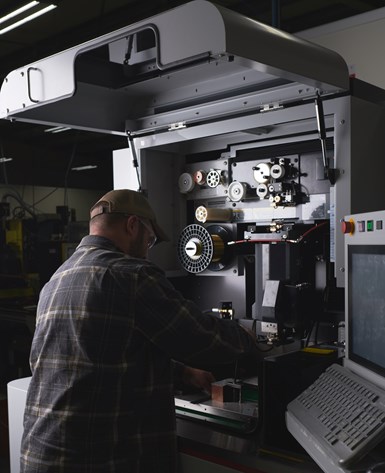
MTD Micro Mold uses fine wire EDM technology capable of producing inside corner radii down to 10 microns.
MTD does all of the design, build, maintenance and repair of its micro molds in-house. Can you share your arsenal of technology and talent that allows that to happen?
Kolb: We have the best people and equipment to support our tooling department, and that includes fine wire EDM technology that enables us to produce inside corner radii down to 10 microns, which translates to molded parts that are essentially dead sharp.
We also utilize our Sarix 3D EDM milling machine that can produce its cutting tool down to five microns in size and milling core and cavity details. Most importantly, we have highly trained toolmakers that know how to drive the equipment and squeeze every bit of capability out of them, and typically, push them past their limits.
You state that MTD “pushes its equipment beyond the published accuracy and repeatability from the manufacturer, which has become our limiting factor.” Can you explain how you “push” your equipment beyond what the manufacturers expect?
Kolb: This primarily pertains to our sinker and wire EDM processes. For sinker EDM, there are many variables that can work against accuracy, such as the variation in the cutting tools that are used to produce the electrodes. The precise machinery that cuts the electrodes still has some error in its axes and the same goes for the sinker EDM. At MTD, we have developed a unique method to remove nearly 100% of the error introduced, ensuring the highest precision and quick tooling lead times.
For wire EDM, the height of the parts that can be cut is limited by the diameter of the wire so the smaller the wire diameter, the shorter the workpiece must be. We invest 10% of annual revenue into R&D efforts, which includes developing new machine settings to push the equipment limits and have been able to machine a 3-inch (76.2-millimeter) tall part with 0.002-inch (0.05-millimeter) wire. According to the manufacturer, the maximum workpiece height for this diameter wire is 0.75-inch (19.05 millimeters).
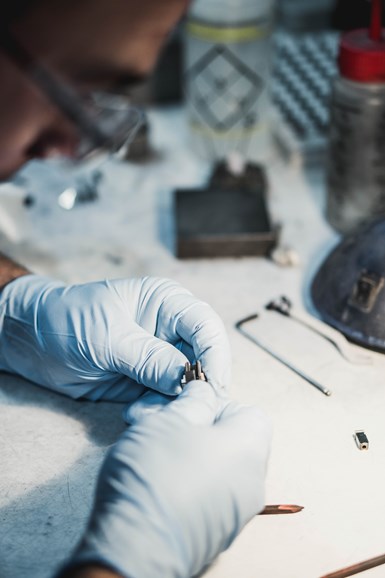
Micro molding trends include tighter tolerances and dimensions, which push MTD Micro Molding to continually improve its processes and invest in new technology.
You note that to date, MTD has not “failed to produce tooling for any designs.” Can you share details of a specific project that tested the team but proved successful in the end?
Kolb: I don’t have a specific project as an example. It’s more about the fact that we design with our technology in mind and if a particular feature cannot be produced with our machine tools, we work with the customer to come up with a design that can be manufactured.
Every project we take on has some level of impossibility and collectively we come up with the most robust design and fabrication plan to achieve the end goal of producing a functional product that meets our customers’ requirements.
Let’s discuss some current micro moldmaking trends and challenges.
Here are 11 key trends we see:
(1) Micro Milling
Kolb: Machine tool manufacturers and tool/work holding manufacturers have been working for years on perfecting this. New drive systems for the machines have been developed that are more reliable and repeatable than traditional methods. Together with machine improvements, tool holding and work holding are critical components to success and having tool holders that are balanced and run true to the centerline of the spindle reduces vibration and maximizes cutting tool life.
(2) Materials
Kolb: There hasn’t been much for new tool steels for micro tooling beyond powdered metals, which we often use for inserts that need to hold a knife-edge.
(3) Cutting Tools
Kolb: I think the biggest thing in new cutting tools isn’t the geometry of the cutting tool, but the coating of the tool. Coatings can be formulated for different material hardness and ductility and can help extend tool life.
(4) Mold Coatings
Kolb: While there are plenty of new coatings, they are more suitable for external insert features. Options are limited for coating the inside of holes that are under 1/16 inch, for example.
They do, however, give us the ability to mold parts without the use of grease and we have discovered a coating that is certified for medical devices, which is critical for the products we manufacture.

Machine tool improvements, toolholding and workholding are critical components to MTD Micro Molding’s success.
(5) CAD/CAM
Kolb: Micro mold simulation has been showing some promising advancements.
(6) Micro Welding
Kolb: While laser welding technology has undoubtedly come a long way and now makes it possible to weld micro inserts, it still is the last resort for us. Even though the sink is minimized, the integrity of the steel is compromised and when the inserts are so tiny, they lose their strength and ductility.
(7) Mold Design
Kolb: Larger parts with micro features seem to increasingly become a bigger part of our portfolio. These are often the most difficult to design due to incorporating larger moving actions that require more “slop” to move freely while trying to incorporate precise, interlocking features.
Another big one, as of late, is allowing for “flash” heating and cooling cycles in the tools for extreme heat tools. This involves using non-traditional heating and cooling methods within the same tool. Steel selections and moving components fall under more scrutiny when tools are subject to these extreme temperature cycles.
(8) Micro Molding
Jared Cicio, Production Manager: I have seen micro-molding trends in customers requiring tighter tolerances and dimensions. These requirements have continued to push us to improve our processes and invest in new, cutting-edge equipment to give us the ability to machine and create molds with features and dimensions that would have been near impossible years ago.
The challenges of building these molds so tightly to control flash create other problems such as venting issues. So, we must carefully walk the fine line between making a mold tight enough to not flash out of tolerance while allowing the mold to vent to properly fill and pack.
(9) Validation
Alex Maroon, Project Manager: From a high level, some trends/challenges with validations that we are currently seeing is an increase in inspection requirements from our customers. We are also seeing an increase in the number of requests for mechanical testing for part functionality, which we manage in-house during the validation process.
(10) Automated Assembly
Cicio: We are seeing more and more requests for us to not only mold devices but also to do all secondary operations such as trimming, assembling, gluing and packaging. As a result, we have had to look more at automating these operations to keep up with customer demands. In addition, with the current state of supply chains, customers see more of a need to work solely with one supplier for all their needs.
(11) Training
Kolb: We are currently working on providing our tool and moldmakers with in-house molding/processing training to better understand what our process engineers deal with on a day-to-day basis.
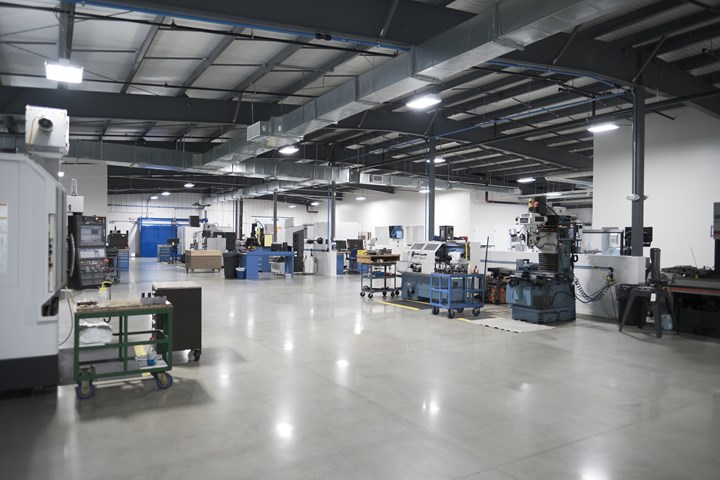
A 2021 facility expansion increased MTD Micro Molding's footprint from 16,000 square feet to 28,000 square feet at its Charlton, Massachusetts location, including a new tooling center.
What do you see as the next advancement in micro moldmaking?
Kolb: Laser machining/engraving has come a long way and shows promise as a potential alternative to micro EDM milling. Also, electroformed mold inserts are being used in microfluidics quite a bit. So we’re looking into incorporating these technologies into future tool designs.
RELATED CONTENT
-
Mold Building for Metals
Designing a mold for MIM is no easy task - tight tolerances and paying the utmost attention to intricate details are just the tip of the iceberg.
-
Leading Mold Manufacturers Share Best Practices for Improving Efficiency
Precise Tooling Solutions, X-Cell Tool and Mold, M&M Tool and Mold, Ameritech Die & Mold, and Cavalier Tool & Manufacturing, sit down for a fast-paced Q&A focused on strategies for improving efficiencies across their operations.
-
Micro-Milling Opportunities and Challenges
An integrated approach to the design and machining of micro-milling components is key for mold manufacturers looking to capitalize on this growing opportunity.









